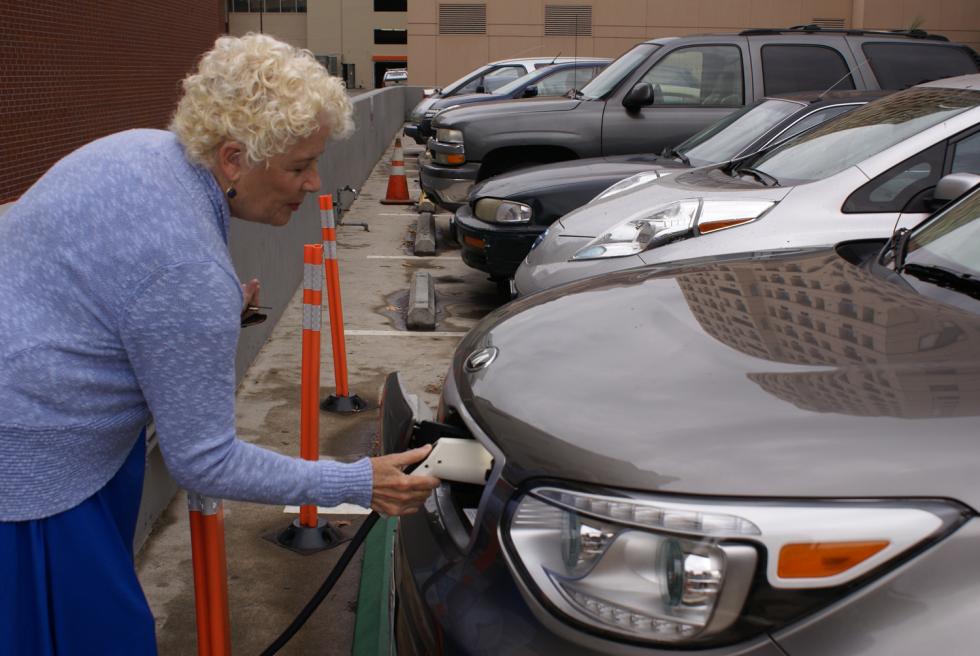Lloyd Levine was expecting a lightweight “glorified golf cart” the first time he got behind the wheel of an electric car. “So when I shut the door and it went ‘thump,’ that was my first thought — this was a solid car,” Levine says. “It drove incredibly smoothly, it felt solid on the road, and when you accelerated, boy that car zoomed. It broke every impression I had at the time of an electric vehicle.”
This was during the late ‘90s, when the first mass-produced, battery-powered vehicle from General Motors became available in select U.S. cities through limited lease-only agreements. Known as the EV1, the plug was pulled on the leasing program after a brief and limited market study into the feasibility of producing and marketing a commuter electric vehicle.
Most of the repossessed cars were literally crushed in a move that drew wrath from customers, electric car enthusiasts and environmental groups. Its abrupt discontinuation is chronicled in the documentary “Who Killed the Electric Car?” and remains a contentious, historically significant industry event.
Levine, a state legislator at the time, is now director of media and public relations for the Sacramento Electric Vehicle Association — and the proud owner of a Chevy Volt, a plug-in hybrid electric vehicle he charges at night. Visits to the gas station are rare, as Levine goes through about a gallon of fuel each month. He jokes that he’s never spilled electricity or had trouble washing the smell off his hands.
As a proponent of quashing electric vehicle myths and getting more “butts in seats,” Levine is in good company with other EV advocates and agencies that have welcomed the news of Sacramento’s designation as Volkswagon’s first “Green City,” an experimental playground for zero-emission vehicle infrastructure, car-sharing services, delivery fleet and education.
As a Green City, Sacramento will receive a $44 million investment from Electrify America, a subsidiary of VW and fallout of the “Dieselgate” scandal in which the German automaker was caught cheating on diesel-emissions tests. (In what’s been the biggest auto industry scandal to date, the $14.7 billion settlement is the largest as well.) Sacramento beat out Los Angeles this past summer as the first of two Green Cities. So far no other city has been chosen.
City officials and EV advocates are banking on this opportunity to mark the Capital Region as a hub for automotive technology, and are already receiving interest from car and technology companies looking to put down roots.
“Northern California is being uniquely positioned to be a place where clean vehicle technology is being done,” says Matt Carpenter, director of transportation services for the Sacramento Area Council of Governments. “We can build on the cluster happening with Tesla and other technology happening in the Bay Area. It’s a near-term investment, but we can use it as a catalyst for long-term investment.”
Seeing Green
The Sacramento money is only a portion of VW’s $800 million commitment to California over the course of four 30-month investment cycles. The California Air Resources Board will oversee Electrify America’s progress, approve its investment plans, and require quarterly and annual reports. An independent auditor will also review VW’s project implementation and finances.
“There are already sparks of innovation here, and that’s why we were chosen.” Matt Carpenter, director of transportation services, Sacramento Area Council of Governments
The investment has the potential to transform the area, says Carpenter. “The significant amount of money to promote zero-emission vehicles is going to be great and will allow us to implement some of the plans already in place,” he says. “There are already sparks in innovation here, and that’s why we were chosen.”
The first statewide spending cycle designates $120 million to be spent on 350 neighborhood charging stations and 50 fast-charging stations, to be deployed in Los Angeles, Sacramento, San Francisco, San Diego, San Jose and Fresno. Another $20 million will go toward brand-neutral, multilingual public awareness campaigns. Added to Sacramento’s $44 million Green City price tag, that leaves $16 million for Electrify America’s internal purposes.
“There are a lot of attributes of Sacramento and the region that make it a great microcosm of the country,” says Mike McKeever, Sacramento Mayor Darrell Steinberg’s chief of staff and whose leadership and team-making capabilities the mayor credits for capturing the Green City designation. McKeever, who previously headed SACOG, adds that Sacramento is an ideal test bed for emerging transportation technologies due to its influence as the capital of the sixth largest economy in the world. “It’s big enough to have urban dynamics, but not so huge that things can’t get done,” he says.
Laying the Groundwork
While the buzz is strong, concepts and projects are in the early phases of discussion. But on the city level, two goals stand out, says Levine of the Sacramento Electric Vehicle Association: first, highly visible, high-impact projects that will promote electric vehicles; second, eliminating major sources of pollution (such as taxi, bus or other fleet vehicles).
“We don’t know exactly what the Green Cities grants will end up paying for,” Levine says. “Volkswagen is still in process of [deciding] what will be funded and how, but some concepts are very exciting.”
Electrify America will focus on developing a ZEV delivery fleet and ZEV taxi provider in Sacramento. Under discussion is electrifying transit from the Sacramento International Airport to downtown, Levine says, which could involve working with the taxi fleet and car-sharing services like Lyft and Uber.
For Levine, a lifelong asthmatic, electric vehicle adoption goes beyond saving money at the gas station. “There’s a health benefit to converting to our fleet. It’s a personal issue, it’s a passion, it’s everything,” he says.
Related - Back and Forward: Lloyd Levine on EV Adoption
In its proposal for Green City status, the City of Sacramento made its case by identifying “shovel ready” sites that can accommodate installations for 15 chargers on City property, including the Sacramento Valley Station, the Sacramento Marina and Fairytale Town. VW’s investment plan lays foundational work to begin in 2017, including the installation of 75 chargers throughout the city. Site development for those is slated to start in early 2018, with development of all stations completed by the end of 2019. Currently Electrify America is evaluating proposals for car share providers and identifying sites to prepare for infrastructure installation, City officials say.
“There’s some time before we’re going to see physical things on the ground,” says Jennifer Gress, staff lead for the City of Sacramento on the Green City initiative.
The idea isn’t to have everyone owning EVs and driving them downtown, McKeever says, as that’s still just a less-pollutive congestion problem. “The goal is to get them into transit to get them into downtown — we can have electric shuttles, getting people to the light rail system, or clean buses bringing them to downtown.”
That first investment cycle cleared a significant hurdle over the summer with approval from the California Air Resources Board, after the agency demanded more details on how VW would invest in disadvantaged communities. The specific locations of Green City investments will be spread across Sacramento, a representative from Electrify America says in an email. “But Electrify America’s geospatial analysis … shows that approximately 59 percent of the Sacramento census tracts in the target geography for Green City Initiative investments are designated as disadvantaged or low-income by California.”
A recent report from the City of Sacramento outlining its EV strategy notes that currently most chargers are concentrated in downtown parking garages, with the remaining at destinations like the UC Davis Medical Center and the Arden Way corridor. At least 35 percent of EA’s total investment is to be aimed at benefiting disadvantaged communities, including $2 to $3 million of the awareness campaign funds slated for partnerships with entities that have access to, and credibility with, low-income and disadvantaged communities.
“We want to be the place where the experiments happen, where the real-world learning happens,” McKeever says. “Change is never smooth, so there will inevitably be physical, economic and attitudinal changes to address, to move from a small segment of the population using electric vehicles, to being a mass-diffused technology.”
The Pace of Change
Susan Brown, 66, lives on about $1,000 a month at the Sacramento Housing Authority’s Edge Water complex across the street from the county jail on I Street. For six months Brown didn’t have a car and relied on a bus that transported residents to Walmart once a month for her groceries.
Susan Brown charges one of two Kia Souls available at Edge Water
Apartments in Sacramento. Before getting access to the vehicles
through Our Community CarShare Sacramento, Brown says she was
“trapped.” photo: karen wilkinson

She felt stuck. She gained weight eating junk food from the corner market and says she became depressed. “These are huge issues that unless you’ve been through it, it’s so hard to grasp the importance of helping seniors to have their freedom, because we’re forgotten,” Brown says.
That all changed for Brown earlier this year when, with the help of a $1.3 million grant from CARB. Sacramento Metropolitan Air Quality Management District launched an electric vehicle car-sharing pilot program at her housing complex. She was one of the first to sign up for Our Community CarShare Sacramento, which provides residents of three Sacramento housing projects with free access to eight electric Kia Souls. Six vehicles are stationed at public housing complexes (Mutual Housing at Lemon Hill, Alder Grove Housing Complex, and Edge Water Housing Complex), and two vehicles are available to registered users at the Sacramento Valley Station. It’s this program that Electrify America intends to expand upon.
Regaining her mobility through the car-share program has been life-changing, says Brown, who is an ambassador for the program and regularly drives other senior citizens on their errands.
“I know how trapped we are without [access to transportation],” she says. “I don’t know whose idea it was to start this here, but God bless them.”
New sites will soon be added, says AQMD Division Manager Tim Taylor. In another expansion of transit services aimed at the underserved is a car-hailing service that would distribute cards, essentially vouchers, to low-income communities with credit for Lyft or Uber rideshare services. “What we’re talking about doing hasn’t been done,” Taylor says.
McKeever says it’s critical to ensure equity is prioritized, so that EV projects close the economic divide instead of widen it.
“Transportation is so central to society and how communities interact,” he says. “We have to make sure the transportation system is helping to improve that dynamic and not make it worse.”
A Growth Industry
This isn’t the first attempt at branding California as a hub for automotive technology. The VW win is in stark contrast to the loss of Tesla’s battery factory in 2014, which ended up near Reno, Nev., despite California lawmakers’ attempts to woo the Palo Alto-based electric car manufacturer. It’s especially significant given that Steinberg, during his time as Senate pro Tem, co-authored the bill intended to lure Tesla in addition to authoring legislation designed to reduce carbon emissions and pollution.
But past losses don’t have to hinder the region’s future as a testing ground for fresh concepts. Carpenter believes that the VW investment might be just the jolt Sacramento needs. “Being a forward thinker about how to take advantage of these [automotive] technologies can market us as a place for innovation,” Carpenter says. “The key is we want to be a region that’s a place to test ideas.”
Through Electrify America’s contractors and partners, City officials hope to see job creation, apprenticeships, internships, the ability to leverage talent from local colleges and universities, and other economic reverberations. Electrify America anticipates its statewide investment will support up to 8,500 jobs over its 10-year investment cycle. The local investment is anticipated to create up to 176 jobs and $27 million in economic output. The job site Indeed.com already has Electrify America job openings in Sacramento for staff fleet administrator, and fleet maintenance and claims admin.
“Transportation has slowly evolved over time,” Carpenter says. “We’re in a state of significant disruption and change. It’s exciting, and that’s why investments like this really jump start us in moving to the future.”
The opportunities to attract and grow Sacramento’s automotive and technology climate are already gaining footing. The “like attracts like” concept of industry clustering is already manifesting, which officials expect to continue.
“The Green City initiative is an exciting platform to launch other initiatives to layer on top of it, to create an environment in Sacramento that’s excited for electric vehicles,” Gress says. “It’s the excitement of Sacramento being a hub for electric vehicles, and how that can attract new ventures.”
Mercedes-Benz recently chose Sacramento and Columbus, Ohio, as markets to deploy dealer education on electric vehicles. According to Gress, Envoy, a new car-sharing service, is assessing the Sacramento market, as is Veloz, a nonprofit that’s grown from the California Electric Vehicle Collaborative that focuses on community education and outreach related to electric vehicles.
“They know this is going to be the place to be,” Gress says, of both big players and smaller startups taking interest in the region. “I firmly believe it is a result of this electric vehicle activity occurring that [companies] are coming.”
There’s also buzz around establishing a research and development center, Gress says, who adds that the types of jobs created through the automotive technology industry will be high paying.
“There’s such an incredible amount of activity on so many fronts, there’s a lot of momentum” she says. “In five to ten years this will be a really different city in regards to transportation.”
Recommended For You

In the Driver’s Seat
James Corless, new CEO of the Sacramento Area Council of Governments, on transportation, housing and autonomous vehicles
James Corless has been called “a world-class visionary and leader” in transportation, land use and creative urban planning by Roseville Mayor Susan Rohan. He became CEO of the Sacramento Area Council of Governments in April, after serving as the founding director of Washington D.C.-based Transportation for America. We sat down with him to discus the future of the Capital Region.

Seek Solutions by Seeking Empathy
The planning stage of our December issue typically starts with a conversation reviewing what we mean by “innovation.” Technology is often only part of it — a starting point, if that. Notable innovation hinges on better solutions to existing problems.




Comments
Technology is such a good thing when it benefits everyone. This article was well written.
As a Proud Native Son of the 916; I am very excited by the opportunity this affords our region! Too many times the naysayers have trampled upon us as a backwoods gov't "only" town. Between this set of options and the solidly established AgTech & MedTech sectors, we have a very b right future indeed!